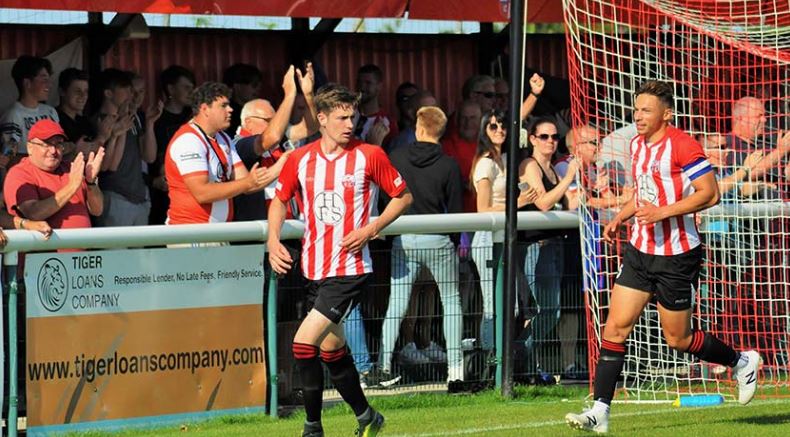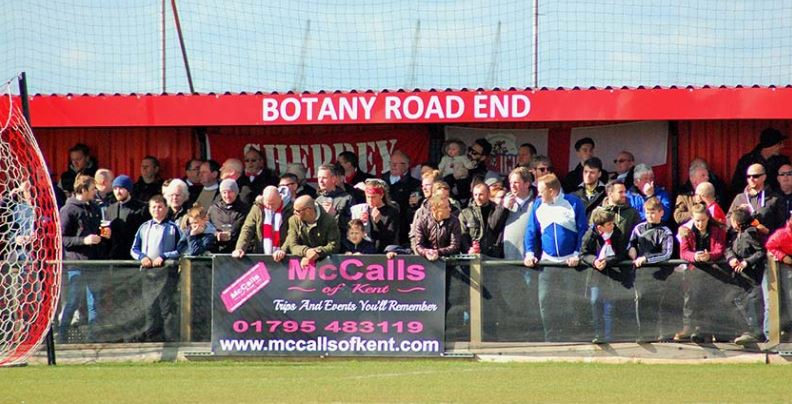‘The Kids Are All Ite’ – Cene Magazine
This month ‘Cene Magazine’ produced a special look at SCEFL’s own Sheppey United – an alternative look at the Club and in Non League Football in general.
It’s well worth a read, so please do….
“SHEPPEY UNITED’S HOLM PARK IS A FOOTBALL STADIUM PULSATING WITH NEW BLOOD. IT’S POPULATED BY YOUTHFUL CREWS MAKING A PROPER SONG AND DANCE ON ITS TERRACES, AS WELL AS 20 AND 30-SOMETHINGS DISILLUSIONED BY THE PREMIER LEAGUE ‘PRODUCT’. AS ANDY GRAY REVEALS, FOOTBALL’S GRASS ROOTS HAVE UNPRECEDENTED VIBRANCY IN THIS LITTLE CORNER OF NORTH-EAST KENT.”
Small stones cause large ripples, a metaphorical example of the way our feelings and opinions can be forever tainted by a brush with something of apparent insignificance.
Take my trip to Faversham Town FC in the early 1990s; a visit that cemented my view of local lower-league football as a penury experience for society’s terminally defeated. For at the Salters Lane ground that day, a smattering of scarf-clad cadavers gathered amongst the crumbling terrace’s weeds to watch football void of panache and quality, on a pitch suited to cabbages rather than kings. It was dire. Yet the wedge that drove a long-lasting enmity between me and this far from beautiful form of the game was the appearance of something far less expected: a freshly-laid turd that confronted me as I entered the club’s ‘toilet’ – an alfresco roofless bunker featuring a solid, brown nasty one as the open-plan concrete floor’s shudder-inducing centrepiece. If further evidence of my arrival at football’s arse-end were needed, there before me lay the stinking, smoking gun. From that moment onwards, below-basement football was dead to me, until…
A couple of decades later, I’m asked if I fancy spending a Saturday afternoon watching Sheppey United – my local team – play.
“What are their toilets like?” I shot back.
‘Eh?’
“Well, the last time I went to a local league game, there was a… oh, it doesn’t matter.”
I attended the game that day, and have been following Sheppey home and away since; a ‘take ‘em or leave ‘em’ supporter to a full-blown obsessive. I should point-out at this stage that I’m married; do not dribble when I talk and do not possess a bus pass. This contrasts sharply with many a non-believer’s view that die-hard non-league devotees are either old men, or eerie-looking young adults who they’d be comfortable leaving their wife with – but not necessarily their kids. Because here’s the thing: Kent non-league football, like the majority of decrepit clients it used to exclusively attract, has gone to a better place. Journey to Sheppey United’s Holm Park on any given Saturday (when they’re at home, preferably) and you’ll experience an atmosphere that shows – in these parts at least – football’s lower reaches can flourish, rather than flounder in the shadow cast by their professional and illustrious counterparts.
On Sheppey’s terracing, ‘crews’ of teenagers have started to line its shallow banks. To the beat of their leader’s drum at the Botany Road End they sing, jump about the place and generally revel in bringing a rarely-heard youthful voice on a football stage; albeit a small one. At Sheppey, where entry for under-16s is £2, kids can afford to rule the terraces – in the way kids used to – and ape the Ultra antics of clubs they can only afford to watch via a screen.
For a club which plays in the Southern Counties Eastern Football League – five ‘steps’ below England’s lowest professional division; nine below the Premier League – Sheppey’s average home gate of more than 200 rates as mighty impressive. The figure not only makes the Ites (as the team is nicknamed) better-supported than the majority of sides two leagues above them, they have one of the best home followings in the country for clubs at their level. On a national scale, between 2015 and 2017, out of nearly 300 teams competing at Sheppey’s level, only South Shields, Bromsgrove, Consett and Worksop – all highly-populated, northern-based football hotbeds – beat Sheppey’s average home gate.

The tub-thumping teens bolstering Sheppey’s supporter ranks never fail to bring the noise to Holm Park. Their songs include a rail against rivals Sittingbourne, claiming them to be a town filled with travelling folk, and a self-deprecating number that references their Island home’s unfounded reputation as a hotbed of incest.
Rambunctious but never unruly, the youths’ forsaking of lower-level spectator norms (talk amongst yourselves/moan) has led to disapproving mutterings from older sections of Sheppey’s support. ‘They don’t even watch the game,’ one well-seasoned Ite mithered via a Facebook post. Others are not as begrudging. Jack Blackmore, 26, is a member of the Elite Squadron, a group which occupies the Paddock area of Sheppey’s ground and whose name is a tongue and check reference to the superior numbers their faction brings to Ites away games.
Jack was born in 1992, the same year as the Premier League, giving him junior status among his ‘Elite’ colleagues. Like his dad, Jack was a Chelsea fan, following the club with true blue zeal before Roman Abramovic’s millions moved in. Four years ago, father and son began pitching-up at Holm Park, rather than Stamford Bridge, a move that gained permanence. “I know it’s been said countless times, but money’s ruined so-called top-level football, “Jack said. “True fans have been edged out in favour of the tourists. Compared to watching Sheppey, going to Stamford Bridge is such a soulless experience. You feel like a customer, just another faceless part of the herd. You’re not allowed to stand-up, you have to watch what you say, and half the time you can’t see anything ‘cause a people in front of you are filming everything on their phones. It’s a day out for them, not a way of life.”
Jack’s living for Sheppey these days. “I never thought I’d feel as passionate about another club, especially one on my doorstep,“ he said. “But by being at Holm Park, match days have become special again. Football at this level means freedom; freedom from long, laborious travel times; freedom to sit or stand where you want, and have a drink while watching the game; freedom from queues at the bar or turnstile, and the petty bureaucracy that has killed the match-day experience at the higher realms. For example, no one at Sheppey’s gonna ask you to remove the top of your water bottle before you enter the ground.”
According to Jack, more people his age are turning to non-league football, ‘cause they’re turned-off by the professional game’. “Chelsea don’t need supporters. All they need is seat-fillers to make them look good on TV,” he scowled “Give me grassroots football any day. From players, to the fans, to the board; everyone’s on first name terms at Sheppey; that old cliché about winning and losing together? That’s us. It’s to the chairman and the manager’s credit that they’ve created a club that younger fans feel so passionate about. Facilities on and off the field are superb – the football’s top-quality, too.”

‘Tis true, facilities at Holm Park – it sits behind a row of houses off one the Island’s main roads – have come on a bundle since Sheppey set-up there in 2013 following a 20-year hiatus due to the original club’s drift to extinction and their old ground being demolished for housing. The first thing you notice when entering the 1,500-capacity stadium is the pitch; a £100,000 luscious green snooker table-flat surface that wouldn’t look out of place in the Premier League due to its installers being the same firm which laid Southampton’s home pitch.
From the refurbished boardroom to the air-conditioned bar and buff changing rooms; everything screams ambition at Holm Park, and plenty have been willing to commit to the dream. The Independent Ites supporters Facebook group has more than 700 members, while Ites TV is the club’s recent media-grab for a wider audience, featuring match highlights and player/staff interviews.
The PR ace up Sheppey’s sleeve is Islander Martin Eaves, a photoshop genius whose brilliantly-imaginative memes – which spread word of upcoming Sheppey fixtures – are as celebrated amongst fans as the team itself. Initially nothing more than Facebook larks, his Sheppey-ing of classic film posters, music covers and the like is now carried in the club’s match-day programme and led to one admirer, Dimitri Massard, forming the Belgian Ites; a small, but growing band who regularly journey from the Lowlands to the Island to watch the team play.
“Non-league football gives you a focal point, a sense of place in the community,” Martin said. “It’s about honest players playing more for the love of the game. There’s a sense of camaraderie, not rivalry between fans of other clubs. Ashford United and Tunbridge Wells have support similar to Sheppey’s. It’s led to a real bond between supporters borne out of respect for the dedication each has to their club. It takes a lot more dedication to support your local non-league club home and away than it does to drop-in now and again at your favourite Premier League ground.”
Stats are designed to make fools of us all, but a survey of 1,000 18-to-24-year-old football fans living in Britain found four-in-five (82%) claimed ticket price was an obstacle to them attending more matches. Cost is a reason, rather than a deterrent to visit a non-league ground. But how long before charges to this accessible world are sent soaring to meet the demands of chairmen with big ideas and zero patience? According to one former Kent league manager – who shall not be named – the player-wage explosion at the top of football’s pyramid is already unbalancing expectations at its base. “A couple of seasons ago the best players at Kent lower league level were asking for £70 per week, now that’s risen to between £200 and £300,” the former coach said. “It’s a figure clubs with only 50 or 60 fans coming through the gate shouldn’t be able to afford. Yet some owners are prepared to risk their club’s future and pay whatever it takes for a slice of football kudos. If success isn’t instant, it’s simple: they take their money elsewhere. You can guess where that leaves the club.”
Sheppey say they are a club that lives within its means, fielding a squad mixed with local and countywide talent. According to Ites chairman Matt Smith, his is a club ‘built from the community, for the community’. In the past he has spoken of his ultimate ambition: seeing Sheppey host a First Round FA Cup tie and maybe competing one or two league levels higher than the one in which they currently reside. The Botany Road End’s bouncing, braying boys’ brigade is proof of the club’s stellar progress off the pitch. They’ve secured a new generation of fans who are learning to love their local club, rather than one they can’t afford to watch.
Cynical islanders will say their home has few claims to fame, but who knows? If the Ites continue to ‘go marching in’ the right direction, this quirky little coastal resort’s future Wikipedia entry might read thus:
The Isle of Sheppey: population 40,000.
Birthplace of Rod Hull – flossy-haired entertainer whose puppet Emu brought him TV fame, but not a decent TV aerial (see death).
Sheppey has three prisons, a nudie beach and Elmley Nature Reserve; a beacon for birdwatchers who flock to the wild and desolate hinterland to observe creatures in their natural habitat (see nudie beach).
The Island’s also home to Sheppey United whose support, sizzling match-day atmosphere and stadium facilities – the toilets feature seamless, faeces-free flooring – are unrivalled in Kent and the south-east for clubs at their level.
‘Come on you Ites’.
For more from Cene Magazine please visit their website here.
Images: Marc Richards

